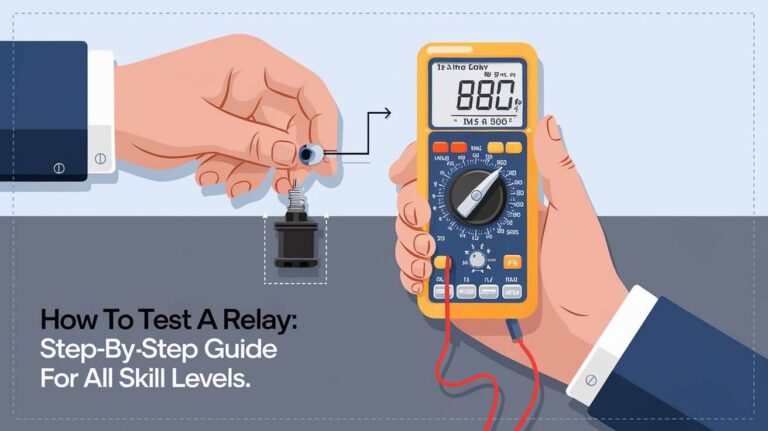Does a Relay Consume Power? Understanding Power Use and Efficiency

Relays are essential components in both industrial and household electrical systems. A relay’s main job is to control electrical circuits by opening and closing contacts in response to signals, allowing it to turn devices on or off remotely. But does a relay consume power in the process? The answer is yes—relays do consume some power, which varies by type, design, and operating mode. Understanding how and when relays use power can help in selecting the most energy-efficient option for any given application. This guide will explore various factors that impact relay power consumption and offer insights on minimizing it for efficiency and longevity.
What is a Relay? Basic Function and Applications
Definition and Purpose of a Relay
A relay is an electrically operated switch used to control circuits in various systems, from home automation to industrial machinery. Essentially, it acts as a bridge that connects or disconnects power to different components when signaled by a low-power control circuit. For example, a relay in a thermostat can switch an HVAC system on or off depending on room temperature.
Types of Relays and Their Uses
Relays are available in several types, each suited for specific applications and power demands. The primary types include:
- Electromechanical Relays (EMRs): These use a physical switch mechanism controlled by an electromagnet. When current flows through the relay coil, it generates a magnetic field that closes the circuit.
- Solid-State Relays (SSRs): SSRs lack moving parts and instead rely on semiconductor components to achieve the same switching effect. SSRs are faster and more durable but may use a constant, albeit small, amount of power.
- Latching Relays: Unlike typical relays, which require continuous power to maintain their position, latching relays need power only to change states, reducing overall energy use.
Examples of Relay Applications
Relays are essential in various applications where remote or automated switching is required:
- Automotive systems: Used to control high-power devices like lights, fans, and pumps.
- Industrial machinery: Control of heavy-duty equipment and automation processes.
- HVAC systems: Enable thermostats to manage heating and cooling systems efficiently.
- Home automation: Allow remote control of lights, security systems, and smart appliances.
Understanding Relay Power Consumption
Does a Relay Use Power When Idle?
A common question regarding relay operation is whether it consumes power while idle. For standard relays, the answer largely depends on the design. Traditional electromechanical relays consume power when the coil is activated, which keeps the switch in a closed position. However, they don’t usually consume energy when in an open state (idle).
In contrast, solid-state relays (SSRs) may consume a small amount of standby power even when not actively switching due to the nature of semiconductor components. Latching relays offer a solution to this by requiring power only when changing from one state to another, making them ideal for applications that demand high efficiency.
Active Power Consumption: How Much Power is Used During Operation?
The power consumption of a relay during operation can vary. Here’s a general overview:
- Electromechanical Relays (EMRs): The power required to activate the relay coil typically ranges from 0.5 to 3 watts, depending on the size and type. The exact value depends on the coil resistance and the voltage applied.
- Solid-State Relays (SSRs): While SSRs generally consume less power during switching, they can require a continuous current on the control side, resulting in a small but constant power draw.
- Latching Relays: These are the most energy-efficient, using power only when switching states.
Solid State Relays (SSR) vs. Electromechanical Relays (EMR) in Power Consumption
Electromechanical and solid-state relays serve similar purposes but differ in power consumption. Electromechanical relays, with their physical movement, tend to use more energy than SSRs due to the coil’s need for a consistent voltage to stay energized. SSRs, while faster and with fewer power spikes, might still draw minor standby power, making them better suited for high-switching frequency applications where efficiency is key.
Factors Influencing Power Consumption in Relays
Operating Voltage and Current
Power consumption in relays is directly related to the voltage and current in the relay coil. Higher operating voltages can lead to greater power draw, especially in EMRs. Lowering the voltage can reduce the relay’s power usage, but this requires careful adjustment to ensure that the relay remains operational.
Coil Resistance and Relay Hold Current
The coil resistance and hold current (current required to keep the relay activated) also impact power consumption. Generally, higher coil resistance requires less current, which reduces power usage. Certain circuits are designed to lower the holding current after initial activation, which is an efficient way to manage power without sacrificing performance.
Environmental Factors: Temperature, Vibration, and Load Types
The surrounding environment can impact relay performance and power use. High temperatures can increase resistance, leading to higher energy use. Additionally, mechanical relays may consume more power when exposed to frequent vibrations, as they need to hold their position against external forces. Similarly, the type of load—whether resistive, inductive, or capacitive—affects both the relay’s stability and power needs.
How to Measure Relay Power Consumption
Measuring Coil Resistance and Voltage
Calculating a relay’s power use requires knowledge of its coil resistance and applied voltage. Power (P) can be calculated with the formula:P=V2RP = \frac{V^2}{R}P=RV2
where VVV is the voltage applied to the relay coil, and RRR is the coil’s resistance. This formula provides a base estimate of the relay’s power usage in its active state.
Using Tools like Multimeters
A multimeter can help measure the actual voltage across the relay’s coil and the current flowing through it. This provides an accurate reading of power consumption. With these tools, it’s also possible to check power usage in standby mode, particularly useful for SSRs and latching relays.
Estimating Overall Power Consumption in Relay Systems
In systems with multiple relays, calculating the total energy consumption involves summing up the power use for each relay. For example, in an automation system with 10 relays, understanding each relay’s power requirements can help in selecting energy-efficient models and calculating operational costs.
Strategies to Minimize Power Consumption in Relays
Latching Relays and Other Low-Power Options
One of the most efficient solutions is to use latching relays, which need power only to switch states. They are ideal for applications where continuous current isn’t required, such as in lighting control systems.
Capacitors and Resistors to Reduce Holding Current
Adding capacitors and resistors to a relay circuit can reduce the holding current needed to keep the relay in an activated state. By temporarily storing energy in a capacitor, the circuit can maintain the relay’s position without a constant power draw.
Choosing the Right Type of Relay for the Application
Selecting the best relay type—whether it’s an SSR, EMR, or latching relay—can significantly impact power use. For instance, SSRs are suitable for frequent switching with low power requirements, while EMRs are more effective for occasional use in high-power circuits.
Comparing Power Consumption: Relays vs. Other Switching Components
Relays vs. Transistors for Switching Applications
Transistors are often used as alternatives to relays for switching, especially in low-power applications. Unlike relays, transistors don’t have moving parts, leading to less energy loss. They can provide a power-efficient alternative, particularly in digital circuits, though relays still have advantages in high-voltage switching.
Efficiency Considerations in Power-Sensitive Systems
In systems like IoT devices or battery-powered circuits, the energy savings from using efficient relays are especially valuable. Latching relays or low-power transistors can extend battery life and reduce operational costs in such scenarios.
Practical Examples of Relay Power Consumption in Everyday Applications
Relays in Home Automation
Home automation systems rely on relays for remote control of devices. Smart home devices often employ low-power relays or solid-state versions to reduce standby power consumption. By using energy-efficient relays, these systems can maintain functionality without excessive energy costs.
Industrial Use Cases: Reducing Power Waste
In industrial settings, relay power consumption can add up, especially in large-scale automated systems. Industries frequently use SSRs or latching relays to reduce power requirements and minimize waste. Managing relay power effectively can lead to substantial savings over time, particularly in facilities with extensive relay use.
Addressing Common Questions on Relay Power Use
Does a Relay Consume Power Continuously?
Some relays, like EMRs, consume power only when actively energized. Others, such as SSRs, might use a minimal amount of standby power due to their semiconductor components. Latching relays are the most power-efficient, consuming power only when switching.
How Does Power Consumption Impact Relay Lifespan?
Higher power consumption in relays, especially EMRs, can lead to faster wear on moving parts. Solid-state relays generally last longer due to the absence of moving components, making them suitable for applications requiring high durability.
Why Do Some Relays Overheat, and How to Prevent It?
Overheating is often due to excessive power consumption or inadequate ventilation. Using relays with appropriate ratings and installing heat sinks for SSRs can help prevent overheating and prolong the relay’s life.
Conclusion
Understanding relay power consumption is key to selecting the right relay type for any application. While standard electromechanical relays require power to maintain their activated state, options like latching relays offer energy-saving benefits. By evaluating factors such as operating voltage, coil resistance, and relay type, you can optimize energy usage and extend relay lifespan, makingits the optimal choice for various systems. Whether in home automation, automotive, or industrial applications, understanding how and when relays consume power can contribute to more sustainable, cost-effective energy use over time. By choosing the right relay and managing power flow effectively, you can maximize performance while keeping energy consumption low.




